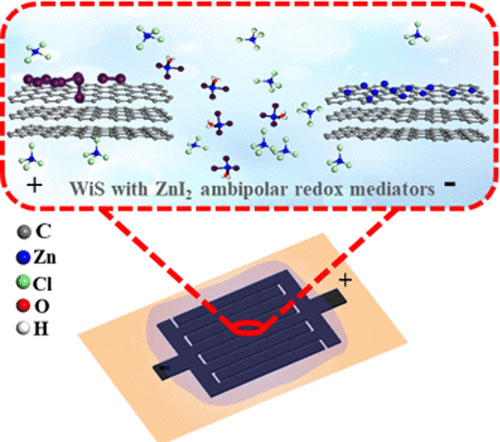| Apr 30, 2022 |
A new strategy to boost pseudocapacitive performance of graphene micro-supercapacitors
(Nanowerk News) Graphene-based micro-supercapacitors (EG-MSCs) combine the distinct properties of graphene and the advantages of planar device configuration to maximize charge storage. Therefore, they can provide more flexible, smaller, and thinner devices.
|
|
However, the limited electric double layer capacity of graphene and the narrow voltage window of aqueous electrolytes limit their further application.
|
|
Recently, a joint resarch team led by Prof. WU Zhongshuai and Prof. FU Qiang from the Dalian Institute of Chemical Physics (DICP) of the Chinese Academy of Sciences (CAS) has proposed a strategy for boosting the capacitance of graphene-based planar MSCs by highly concentrated water-in-salt ambipolar redox electrolyte (ZnI2 + ZnCl2).
|
|
This study was published in ACS Energy Letters ("Water-in-Salt Ambipolar Redox Electrolyte Extraordinarily Boosting High Pseudocapacitive Performance of Micro-supercapacitors").
|
 |
| Graphical abstract of the work. (© ACS Energy Letters)
|
|
Using redox-active electrolytes to boost graphene electrodes is a highly-efficient strategy to increase the capacitive performance of MSCs.
|
|
However, previously reported redox mediators could only offer a certain capacitance for a single electrode, leading to limited energy density due to the unmatched capacitances of two electrodes.
|
|
In this study, the researchers developed a novel highly concentrated water-in-salt ambipolar redox electrolyte where one ambipolar mediator (ZnI2) could offer two redox couples (I-/I2 and Zn/Zn2+) natively, with matched charge storage.
|
|
These two species allowed two electrons to be oxidized at the positive electrode and to be reduced at the negative electrode synchronously and individually, thus offering a large pseudocapacitive contribution for EG-MSCs.
|
|
They have realized high volumetric capacity of 106 mAh/cm3, energy density of 111 mWh/cm3, and long-term cycling stability with 92.1% retention after 5,300 cycles.
|
|
In situ characterizations confirmed that these good performances were attributed to the frustrated self-discharge by suppressing the formation and diffusion of polyiodide ions of I3- and I5-.
|
|
Moreover, EG-MSCs showed stable cycling performance at -20 °C owing to the reduced freezing point of water by strong interactions between water molecules and zinc ions.
|
|
"This work opens a new avenue of introducing ambipolar redox mediators into highly concentrated electrolytes for high-performance MSCs," said Prof. WU.
|

